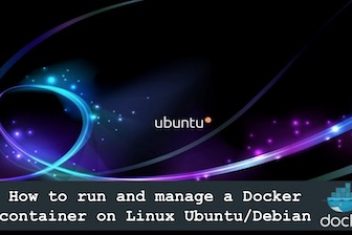Encountering the error message exec: "#executable_name#": executable file not found in $PATH is a frequent challenge when working with Docker containers.
This error typically arises when attempting to start a container using a specific command defined via CMD or ENTRYPOINT in a Dockerfile, or when executing a command directly with docker run. It signals that the container’s runtime environment cannot locate the specified executable within the directories listed in its $PATH environment variable.
This article analyzes the common reasons behind this error and presents several solutions derived from typical troubleshooting scenarios, covering aspects from command syntax to image configuration.
Understanding the Root Causes
The “executable file not found” error can stem from various issues within the Docker environment or the way commands are structured:
- Command Syntax in
docker run: The order of arguments provided to thedocker runcommand is strict. Options must precede the image name, and the command (if any) must follow the image name. CMD/ENTRYPOINTFormat: Dockerfiles allow specifying commands in two formats: shell form (CMD command param) and exec form (CMD ["executable", "param"]). The exec form runs the command directly without a shell, potentially bypassing shell environment initialization, including$PATHmodifications. The shell form executes via/bin/sh -c, which involves a shell.- File Permissions: Scripts or binaries intended for execution might lack the necessary execute permissions within the container’s filesystem.

- Executable Existence: The required executable or script might not be present in the container image, possibly due to issues in the build process (e.g., missed installation step, wrong stage in multi-stage builds).
$PATHVariable Issues: The$PATHenvironment variable inside the container might not include the directory where the executable resides, or it might have been overwritten incorrectly.- Shell Interpreter Problems: If running a script, the interpreter specified in the shebang line (e.g.,
#!/bin/bash) might not exist in the container (common in minimal images like Alpine), or the script file might have incorrect line endings (e.g., Windows CRLF instead of Linux LF). - Dynamic Linking Errors: An executable might depend on shared libraries that are missing from the container image (e.g., binaries compiled with glibc running on an Alpine image using musl libc).
- Volume Mount Conflicts: Mounting a volume from the host can obscure files within the image at the mount point, potentially hiding the executable if the mount path overlaps.
- Incorrect Image Import: Using
docker importon a TAR file created bydocker savestrips essential metadata likeCMDand environment variables, unlikedocker loadwhich preserves them. - Base Image Limitations: Minimal base images might lack common utilities or even a standard shell like
bash. - Docker Cache/State: Stale Docker cache or artifacts can sometimes lead to unexpected behavior.
Read: How to Fix Cannot connect to the Docker daemon at unix:/var/run/docker.sock
Solutions to Resolve the Error
Based on the potential causes, here are several approaches to rectify the “executable file not found” error:

1. Correct docker run Argument Order
Ensure that the options for docker run appear before the image name, and any command to run inside the container appears after the image name.
Incorrect Syntax:
docker run #image_name# -v $(pwd):/src -it #command#Correct Syntax:
docker run [OPTIONS] #image_name# [COMMAND] [ARG...]
# Example:
docker run -v $(pwd):/src -it #image_name# #command#Similarly, ensure flags like -ti or -d also precede the image name.
Read: How to Fix ‘Release is not valid yet’ Error During apt-get update in Ubuntu Docker Containers
2. Adjust CMD/ENTRYPOINT Format in Dockerfile
If the command relies on shell processing or environment variables set up by shell initialization files, use the shell form. If direct execution is intended and dependencies are met, the exec form (JSON array) is appropriate.
Exec Form (runs directly, no shell):
CMD ["executable", "param1", "param2"]
ENTRYPOINT ["executable", "param1"]Shell Form (runs via /bin/sh -c):
CMD executable param1 param2
ENTRYPOINT executable param1Using the shell form (e.g., changing CMD ["grunt"] to CMD grunt) often resolves path issues because the shell helps locate the command via the $PATH.
Note that if the command itself contains spaces, the exec form requires splitting it: CMD ["grunt", "serve"] is correct, while CMD ["grunt serve"] is incorrect as it looks for an executable named “grunt serve”.
Read: How to Resolve ‘docker: not found’ in Jenkins Docker Container Pipelines
3. Ensure Script Executability and Specify Interpreter
If the executable is a script (e.g., entrypoint.sh), ensure it has execute permissions and its interpreter is available and correctly invoked.
- Add Execute Permissions in Dockerfile:
COPY entrypoint.sh /usr/local/bin/ RUN chmod +x /usr/local/bin/entrypoint.sh - Explicitly Call Interpreter in
ENTRYPOINT(Exec Form): If direct execution fails, explicitly invoking the shell can help.# For bash-based images ENTRYPOINT [ "bash", "/usr/local/bin/entrypoint.sh" ] # For sh-based images (like Alpine) ENTRYPOINT [ "sh", "/usr/local/bin/entrypoint.sh" ] - Check Shebang and Line Endings: Ensure the script starts with the correct path to the interpreter (e.g.,
#!/bin/shor#!/bin/bash) that exists within the container. Also, ensure the script uses Linux line endings (LF). Tools likedos2unixcan fix line endings if necessary.

4. Verify Executable Presence and $PATH
- Check Installation: If you are using multi-stage builds, ensure the command or its package is installed in the final stage of your Dockerfile.
- Inspect
$PATH: If the executable is installed in a non-standard location, add its directory to the$PATHenvironment variable in your Dockerfile:ENV PATH="/path/to/your/bin:${PATH}" - Interactive Debugging: Run the container with an interactive shell to manually check if the file exists and is in the path:
docker run -it --rm #image_name# /bin/sh # Inside the container: ls -l /path/to/your/executable which #executable_name# echo $PATH
5. Address Missing Dependencies or Incompatible Binaries
- Check Dynamic Libraries: Use
lddinside the container to check for missing shared libraries:# Inside the container (after installing ldd if needed): ldd /path/to/your/executable - Handle Alpine glibc Incompatibility: If running binaries compiled for glibc environments on Alpine Linux (which uses musl libc), install a glibc compatibility layer.
# Add these lines to your Alpine-based Dockerfile RUN apk --no-cache add ca-certificates wget && \ wget -q -O /etc/apk/keys/sgerrand.rsa.pub https://alpine-pkgs.sgerrand.com/sgerrand.rsa.pub && \ wget https://github.com/sgerrand/alpine-pkg-glibc/releases/download/2.28-r0/glibc-2.28-r0.apk && \ apk add glibc-2.28-r0.apk*(Note: Use appropriate versions and verify security implications.)*
- Check Architecture: Ensure the binary’s architecture matches the container/host architecture, especially when dealing with cross-platform builds (e.g., ARM vs. x86_64).
6. Handle Shell Unavailability (Minimal Images)
- Use
shon Alpine: If using Alpine Linux and a command requires a shell (e.g., in `docker-compose.yml`’s `command` directive), use `sh -c` instead of `bash -c`, as `bash` is not included by default.# Example docker-compose.yml command: command: sh -c "python manage.py runserver 0.0.0.0:8000" - Inject a Shell: For images completely lacking a shell, you can copy one in, such as `busybox` which provides `sh`.
# Create a temporary container to extract busybox docker create --name temp-busybox busybox:1.31.0 # Copy busybox binary out docker cp temp-busybox:/bin/busybox busybox # Copy busybox into your target container (replace #container_id#) docker cp busybox #container_id#:/busybox # Execute commands using the copied busybox shell docker exec -it #container_id# /busybox sh
7. Check for Volume Mount Conflicts
Be cautious when mounting volumes. If a volume mount path (e.g., -v /host/path:/container/path) corresponds to a directory within the image that contains your executable (e.g., /container/path/executable), the volume mount will hide the original image contents at that path. Ensure your volume mounts do not overlay necessary binaries or directories.
8. Correct Docker Image Loading Method
If you are transferring Docker images as TAR files, use docker load to restore the image with its metadata (layers, `CMD`, `ENV`, etc.). Using docker import creates a new, flat image without this crucial metadata, which can lead to this error.
Incorrect (loses metadata):
docker import #imageName#.tarCorrect (preserves metadata):
docker load -i #imageName#.tar9. Resolve Environment Variable Issues with --env-file
When extending the $PATH variable, defining it using ENV in the Dockerfile is generally more reliable than attempting to modify it via --env-file during docker run. Variable expansion (like resolving $PATH within the definition PATH=$PATH:/new/path) might not work as expected with --env-file, potentially leading to a corrupted PATH.
10. Clear Docker Cache and Restart
In some persistent cases, Docker’s build cache or other artifacts might be causing issues. Pruning system artifacts and restarting the Docker service can sometimes resolve unexplained problems.
# Warning: This removes stopped containers, unused networks, dangling images, and build cache.
docker system prune -a
# Then, restart the Docker daemon/service.Verification
After applying a potential fix, rebuild your Docker image (if changes were made to the Dockerfile) using docker build . -t #your_image_name# and then try running the container again with the intended command: docker run #your_image_name#.
You can also use the interactive shell method (docker run -it --rm #your_image_name# /bin/sh) to confirm the executable is now findable via which #executable_name# or directly executable via its full path.
Conclusion
The “executable file not found in $PATH” error in Docker, while common, can be traced back to a range of causes including incorrect command syntax, missing files or permissions, incompatible environments, or improper configuration within the Dockerfile or runtime commands. By systematically checking the argument order, command formats (shell vs. exec), file permissions, executable presence, $PATH integrity, base image compatibility, and Docker state, developers and administrators can effectively diagnose and resolve this issue, ensuring containers run as expected.
If you like the content, we would appreciate your support by buying us a coffee. Thank you so much for your visit and support.



